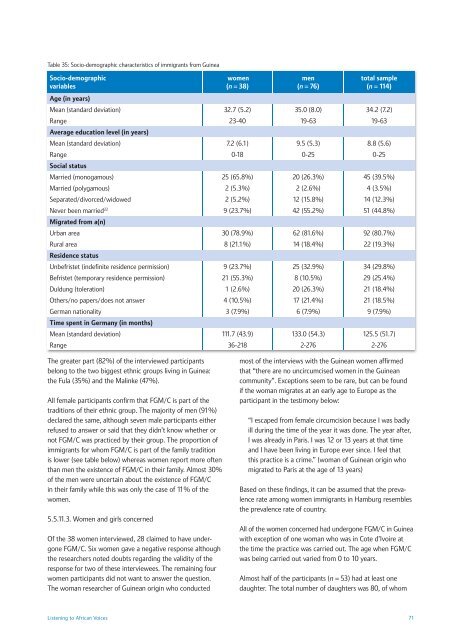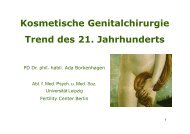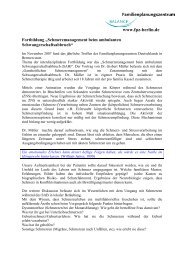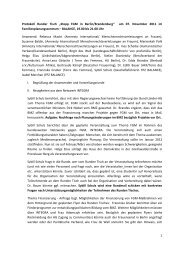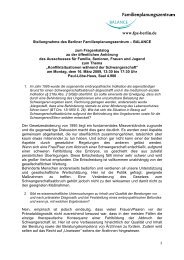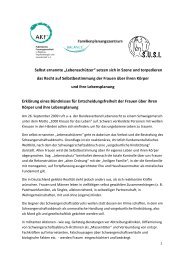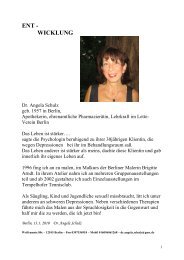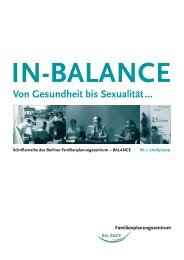Listening to African Voices - FPZ
Listening to African Voices - FPZ
Listening to African Voices - FPZ
Create successful ePaper yourself
Turn your PDF publications into a flip-book with our unique Google optimized e-Paper software.
Table 35: Socio-demographic characteristics of immigrants from GuineaSocio-demographicvariableswomen(n = 38)men(n = 76)<strong>to</strong>tal sample(n = 114)Age (in years)Mean (standard deviation) 32.7 (5.2) 35.0 (8.0) 34.2 (7.2)Range 23-40 19-63 19-63Average education level (in years)Mean (standard deviation) 7.2 (6.1) 9.5 (5.3) 8.8 (5.6)Range 0-18 0-25 0-25Social statusMarried (monogamous) 25 (65.8%) 20 (26.3%) 45 (39.5%)Married (polygamous) 2 (5.3%) 2 (2.6%) 4 (3.5%)Separated/divorced/widowed 2 (5.2%) 12 (15.8%) 14 (12.3%)Never been married 22 9 (23.7%) 42 (55.2%) 51 (44.8%)Migrated from a(n)Urban area 30 (78.9%) 62 (81.6%) 92 (80.7%)Rural area 8 (21.1%) 14 (18.4%) 22 (19.3%)Residence statusUnbefristet (indefinite residence permission) 9 (23.7%) 25 (32.9%) 34 (29.8%)Befristet (temporary residence permission) 21 (55.3%) 8 (10.5%) 29 (25.4%)Duldung (<strong>to</strong>leration) 1 (2.6%) 20 (26.3%) 21 (18.4%)Others/no papers/does not answer 4 (10.5%) 17 (21.4%) 21 (18.5%)German nationality 3 (7.9%) 6 (7.9%) 9 (7.9%)Time spent in Germany (in months)Mean (standard deviation) 111.7 (43.9) 133.0 (54.3) 125.5 (51.7)Range 36-218 2-276 2-276The greater part (82%) of the interviewed participantsbelong <strong>to</strong> the two biggest ethnic groups living in Guinea:the Fula (35%) and the Malinke (47%).All female participants confirm that FGM/C is part of thetraditions of their ethnic group. The majority of men (91%)declared the same, although seven male participants eitherrefused <strong>to</strong> answer or said that they didn’t know whether ornot FGM/C was practiced by their group. The proportion ofimmigrants for whom FGM/C is part of the family traditionis lower (see table below) whereas women report more oftenthan men the existence of FGM/C in their family. Almost 30%of the men were uncertain about the existence of FGM/Cin their family while this was only the case of 11% of thewomen.5.5.11.3. Women and girls concernedOf the 38 women interviewed, 28 claimed <strong>to</strong> have undergoneFGM/C. Six women gave a negative response althoughthe researchers noted doubts regarding the validity of theresponse for two of these interviewees. The remaining fourwomen participants did not want <strong>to</strong> answer the question.The woman researcher of Guinean origin who conductedmost of the interviews with the Guinean women affirmedthat “there are no uncircumcised women in the Guineancommunity”. Exceptions seem <strong>to</strong> be rare, but can be foundif the woman migrates at an early age <strong>to</strong> Europe as theparticipant in the testimony below:“I escaped from female circumcision because I was badlyill during the time of the year it was done. The year after,I was already in Paris. I was 12 or 13 years at that timeand I have been living in Europe ever since. I feel thatthis practice is a crime.” (woman of Guinean origin whomigrated <strong>to</strong> Paris at the age of 13 years)Based on these findings, it can be assumed that the prevalencerate among women immigrants in Hamburg resemblesthe prevalence rate of country.All of the women concerned had undergone FGM/C in Guineawith exception of one woman who was in Cote d’Ivoire atthe time the practice was carried out. The age when FGM/Cwas being carried out varied from 0 <strong>to</strong> 10 years.Almost half of the participants (n = 53) had at least onedaughter. The <strong>to</strong>tal number of daughters was 80, of whom<strong>Listening</strong> <strong>to</strong> <strong>African</strong> <strong>Voices</strong> 71


